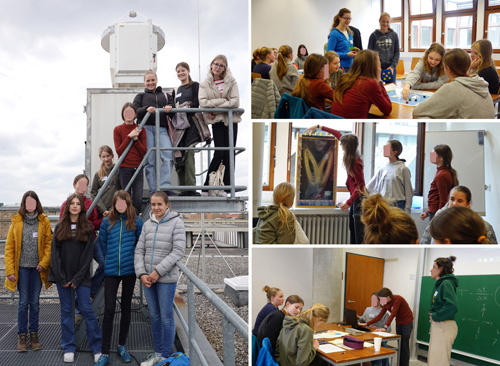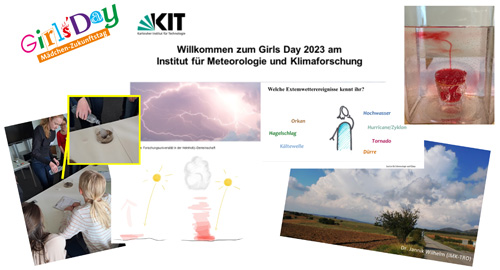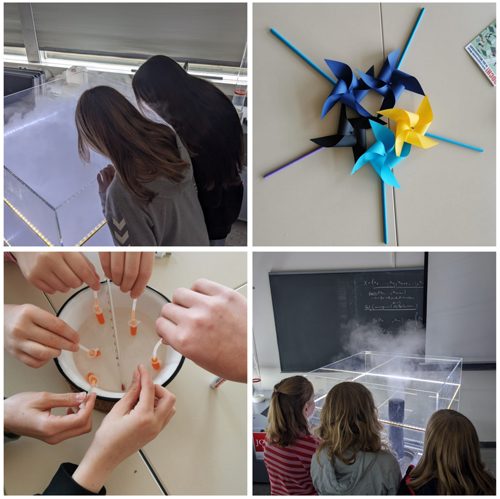Girls' Day 2023
 Girls' Day is a countrywide event to introduce schoolgirls to disciplines and careers in which women are usually underrepresented. More information on this event can be found here.
Girls' Day is a countrywide event to introduce schoolgirls to disciplines and careers in which women are usually underrepresented. More information on this event can be found here.
This year, Girls' Day took place on Thursday 27 April 2023.
W2W female scientists and colleagues at the meteorological institute at the LMU in Munich introduced twelve girls between 11 and 14 years old to weather and weather forecasting during a workshop called "The weather: wind, clouds and science" (in German: "Das Wetter: Wind, Wolken und Wissenschaft"). Bernhard Mayer opened the event by presenting the institute and the diverse areas of research. The participants then played a "Monte Carlo game" to learn about solar radiation, and weather and climate in general. Each participant played the role of a photon, starting from to the top of the atmosphere and aiming at reaching a solar panel. In order to avoid being absorbed, the photon (i.e. the participant) had to answer questions about weather, climate, etc. The participants then played the "Forecast Factory", a game in which each participant is a grid point of a numerical weather prediction model forecasting the temperature in Germany. Each participant computes the temperature at this grid point for a few time steps, communicating with neighbors to exchange information about boundary conditions. The resulting temperature forecast is then compared to the "real" model forecast. This great team work highlights the challenges of NWP and the effects of error growth on a forecast. After a lunch break, the school girls visited the roof instruments. They then visited a poster exhibition about role models in STEM fields, reading inspiring stories featured in the comic book "Of course!". They then learned about the need for ensemble forecasts by playing with the "Meteo Flipper" constructed by Federico Grazzini. This game is a vertical wooden board with nails that deviate marbles as they roll down so that the marbles land "randomly" into "sunny", "cloudy", "snowy" prediction boxes (see photo below). The day ended by a visit of the institute and the interview of a few scientists about their everyday life at work. At the end of the workshop, a participant wrote: "A take-home message for me is that women also have the opportunity to become professors and achieve something great in science. "
The program of the workshop is available here.
 Participants in Munich
Participants in Munich
W2W female scientists and colleagues at the Institute of Meteorology and Climate Research at KIT offered a workshop called "Vom Wetter zum Unwetter" (in English: "From weather to extreme weather"). The program is available here. Eleven girls who wanted to learn more about the profession of meteorologist visited the institute. This year's program was extensive and interactive. Hans Schipper from the Süddeutsches Klimabüro introduced the participants to how weather actually develops, how a forecast is made and how climate change influences extreme events. Various natural disasters were then discussed using pictures and the participants assessed how serious the consequences of each disaster can be for the population and the economy. After the lunch break in the canteen, the girls carried out various experiments in groups on greenhouse effect, convection, ice formation in clouds, droplet formation and air humidity measurements. The highlight of this session was the successful attempt to form ice on pine cones with supercooled water. The workshop ended with a few tips on excursion destinations with a meteorological background. It was an exciting experience for everyone.

Activities at KIT
W2W female scientists and colleagues at the Institute for Atmospheric Physics at the JGU in Mainz offered a workshop called "Was benötigt man für eine Wettervorhersage?" (in English: "What do you need for a weather forecast?"). Isabelle Prestel, Amelie Mayer and Marius Thomas welcomed 12 girls from 5th – 6th grade at their institute. The aim of the workshop was to find out how weather predictions are made and what the key ingredients are. Peter Spichtinger opened the workshop and presented the various meteorological topics and research interests at the institute. After providing a short explanation of how weather prediction works, the girls then engaged in a discussion about the upcoming weather conditions, thereby introducing the important meteorological variables that need to be measured to run a weather prediction. To measure these variables, they build their own thermometer and windmill. Despite facing some challenges during the calibration process of the thermometer, the girls worked hard and did their best. They also got the opportunity to test their windmills with a regular ventilator since the wind channel was under repair. After a refreshing lunch break at the Botanical Garden, the girls visited the rooftop instruments. They then had a look at the cloud chamber, where they could touch a cloud. This gave them a chance to see firsthand how meteorological data is collected. More information is available here.
 Participants at JGU Mainz
Participants at JGU Mainz

